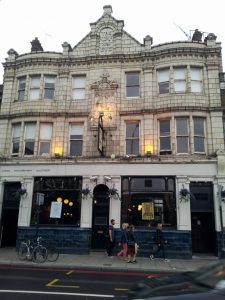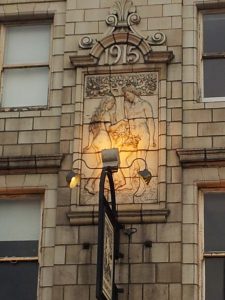The last month or so brought an enriching new experience into my life, and guess what: it involved cycling!
What’s been interesting about this though is that it’s been a sort of vicarious experience, and the vicarious bit has been scary and sobering: seeing London cycling through another’s eyes.
This all started when my 23 year old daughter decided that she really should start cycling everywhere she reasonably can in London. She’s back home and entering the final year of a four year degree at University College London (UCL), about 11km from home by bike. She’s always been a stalwart user of public transport and passionately politically aware, socialist and particularly focused on gender, sexuality and disability equity issues. I think she’s always sympathised with one of my arguments for cycling here in London: that my doing it frees one more space on London’s often horrifically overcrowded public transport for others who don’t have the choice to cycle. However, until now she has said it seemed too dangerous and unattractive.
I’m not sure what changed her mind, perhaps her younger brother cycling quite a bit in London, though his cycling is almost all just around where we live. Maybe him cycling pretty much everywhere he needs to when he’s at university up in Glasgow changed things. I know it was partly that it was a way to get steps onto her fitbit and get around town while saving herself money!
Anyway, she asked if I’d lead her on some of the main trips she could do. We worked out that could take over the bike I’d had in Nottingham when my weeks were split between there and here and it, as luck would have it, it turns out that she likes it and that it can fit her pretty well.
So I’ve been sort of learning to cycle in London for a second time. However, this time through the eyes of a very fit, risk and conflict averse, 23 year old, not a battered 60 year old who has been cycling most places he could for much of his life, certainly for most of the last 50 years. It’s been an interesting experience as it has really brought home to me how desperately unfriendly to cycling London still is, and just how bizarrely incoherent much of the cycling provision has been.
One example is the cycle track on the Vauxhall Bridge Road to the north of the river. This is one of the genuinely protected bits of cycle track in London. That’s to say that there’s a kerb between the cycle track and the road. That’s great in principle as it’s so much safer than sharing the road with motor traffic. This particular track is also “contraflow”: the track is two way to one side of the road so if you’re cycling north here, as we were, you are on the right hand side of the road with the motor traffic going the opposite way just across that kerbing on your left. (International readers remember that in the UK we ride/drive on the left hand side of the road, the opposite side to most of the rest of the world). I don’t much like contraflow cycle lanes as they almost always involve a point where you have to stop and cross the motor traffic and you’re usually waiting some time to be given permission to do that. Because of this, though it’s been there for a couple of years, I’ve always stuck to the usual road going north on this route, eschewing the cycle track. However, with my daughter’s safety in mind, I took the cycle track this time and we bowled along toward Victoria … and suddenly, with what seemed to both of us almost no warning, the track stopped. There was a turning to the right up a side street, definitely not where we wanted to go, and the alternative was to haul on the brakes, shuffle up to the pedestrian crossing and hit the button and wait for that to stop the traffic on the main road and give us a chance to cross that and regain our northbound journey, now with no cycle track or protection at all.
Going the other way on that cycle track you have another daftness: the irritation of being stopped for minutes at at least two crossroads with minor side roads. Cycling in the cycle lane you’re forced to wait when cars, and you had you chosen to eschew the cycle lane, could zoom on with the full priority of the main road. Why so? Because the road planners have correctly decided to protect cyclists from one of the principle killers of our kind: the “left hook without looking properly” death blow. Great! I love it when planners look after my hide. I love it infinitely more, if the mathematical/obsessional among you will forgive the hyperbole, when they protect my daughter’s life. However, why should cyclists wait minutes at each junction to stay safe? It’s the same in the cycle lane on Blackfriar’s Road going north, another road I know well. I’m losing minutes of my life every time I take these routes.
(I know, I know, I should slow down, be less impatient, get a life … and yet sometimes you really are in a hurry and, hey, the same can be said to the car and lorry drivers: if they just looked before hooking left in a hurry no-one would die and we wouldn’t need this daftness. And while you’re on at me with this “slow down, get a life” stuff, yes, I notice that I lied there: we would all still die but not from the famous hook left, motor vehicle squashes human flesh, death blow.)
There is a very simple answer, far, far better in the long run than these infuriating lights that hold cyclists back for minutes while almost no motor vehicle actually does turn left around us: give onward traffic automatic priority even if that onward traffic happens to be a bicycle on your inside. That doesn’t stop idiots hanging a left too fast, without looking and hence squashing and killing us, but it makes it far, far harder for them to get away without being charged with anything less than causing manslaughter by careless driving and, in the long run, it would change priorities and thinking. All it takes is a small change in the law, one other countries have already adopted, see https://www.britishcycling.org.uk/campaigning/article/20170627-campaigning-news-Highway-Code-rule-changes-could-cut-traffic-queues-by-almost-half-0.
Now that brings me to my wider pondering: this really is an issue that kills people. I won’t put the factual links here but just remember two junctions I used to cycle across regularly on the way to my old job: Bank and the huge one on Whitechapel High Street by the Aldgate East tube station. Within months of each other, both junctions gained photocopied pages in those A4 plastic wallets with photos of heart rendingly lively, smiling young women who died there cycling. It took weeks before, in the harsh way of human adaptation, the lights might stop me there and me not feel nauseous thinking of the numbers of their family members and friends who had lost so much. Aye there’s the rub: it’s not for me I really fear, or rather it is: it’s my fear of my losing my daughter, my son, my wife (if she decides to cycle more), a friend, a colleague.
So poor provision for cycling in London kills and regularly, and the evidence that we can make it safer is there. Certainly London with its pre-20th Century roads (and the largely awful, motor traffic oriented 20th Century ones that were cut into it) poses challenges but they’re not insuperable. The evidence that increasing cycling makes everyone who cycles leaner, fitter, happier is strong. It’s clear it would free up public transport for others who can’t. It’s crystal clear that it would reduce carbon emissions and global climate change, not to mention reducing other pollution. So our politicians and civil servants will be getting on and fixing this, yes?
Well, yes, a little, and yes, I do thank you all for that. Oh but so much of it, as I’ve been seeing through younger, less innured eyes, has been done oh so badly. Now that’s because to do things well, you really have to change the way people think, not just do quick, and often flagrantly the cheapest, things. To do things well needs real thought, experience, experimenting, and yes, it costs money, though still a fraction of what you will go on spending on motor traffic provision. If you don’t know about doing it well you really have to assume that others (probably in the Netherlands, Denmark and some other countries) do know how to do it, and you have to go and learn from them. Have a look at:
(Wow, that’s the second huge URL in this now rather long post. I plead that it does warn you what you’re in for, and the whole post isn’t that much longer than the URL, … OK, I lied about that, it’s about an old fashioned page of A4 I’d guess, but it’s shorter than this post!)
Somewhere between every week and every month I get alerted to a “public consultation” like the one he’s referring to in that post. I think I probably average over a hour a week digesting the plans, looking at the options, and replying. I’d looked at that one already and given up trying to give detailed criticism as it seemed almost hopeless. I was relieved to see that someone who clearly knows far more than I do about accumulated, collective experience on these things, had had exactly the reaction I had had: “great, real commitment … but wait a minute, this is rubbish!”
How do we get things to change? Despite my obsession with cycling, I’m not really talking about cycling provision here, it’s just an exemplar, one of hundreds, of how collectively, but perhaps particularly in the UK and US at the moment, we seem to be making terrible decisions and failing to think things out slowly and carefully, and failing to think for the far distant future. Another example of how we are abusing future generations, like this daughter of mine, who is continuing, courageously, to cycle, and beyond her, to the centuries and generations to come? How can we start making decisions that will leave them a less damaged world, fewer unnecessarily dead people, fewer bitter, bereft relatives, some real hope?
Answers on postcard … or, if you’re impressively 21st Century, you can sign up and leave comments!


 Enough of that, well, not quite. It was a lovely pub and had the unusual distinction of having an L-shaped pool table. I was a bit overfaced by the evening which was had a mixed sample of my fellow staff from the Trust: a good number of psychiatrists in training and a good number of older colleagues, mostly but not all from that little building across the road. I think I’ve always found myself two not completely miscible groups of friends, acquaintances, peers, colleagues throughout my life. Hm, topic for a post there some time thinking on how true that has been.
Enough of that, well, not quite. It was a lovely pub and had the unusual distinction of having an L-shaped pool table. I was a bit overfaced by the evening which was had a mixed sample of my fellow staff from the Trust: a good number of psychiatrists in training and a good number of older colleagues, mostly but not all from that little building across the road. I think I’ve always found myself two not completely miscible groups of friends, acquaintances, peers, colleagues throughout my life. Hm, topic for a post there some time thinking on how true that has been.

